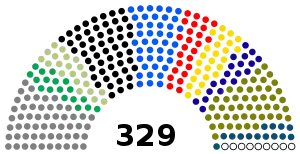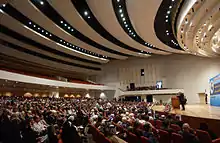Council of Representatives of Iraq
The Council of Representatives (Arabic: مجلس النواب, romanized: Majlis an-Nuwwāb al-ʿIrāqiyy; Kurdish: ئهنجومهنی نوێنهران, Enjumen-e Nûnerên) is the unicameral legislature of the Republic of Iraq. As of 2020, it comprises 329 seats and meets in Baghdad inside the Green Zone.
Council of Representatives مجلس النواب (Arabic) ئهنجومهنی نوێنهران (Kurdish) | |
|---|---|
.svg.png.webp) | |
| Type | |
| Type | |
| History | |
| Founded | 2005 |
| Preceded by | National Assembly of Iraq (1980-2003) |
| Leadership | |
Deputy Speaker | |
Deputy Speaker | |
| Structure | |
| Seats | 329 |
 | |
Political groups | Government (178)
Opposition (152)
|
| Elections | |
| First-past-the-post (after 2019) | |
Last election | 12 May 2018 |
| Meeting place | |
 | |
| Green Zone, Baghdad | |
| Website | |
| www.parliament.iq | |
.svg.png.webp) |
|---|
| This article is part of a series on the politics and government of Iraq |
|
|
| Constitution |
|
|
History
The monarchy
An elected Iraqi parliament first formed following the establishment of a constitutional monarchy in 1925. The 1925 constitution called for a bicameral parliament whose lower house, the Chamber of Deputies of Iraq or Council of Representatives (Majlis an-Nuwwab) would be elected based on universal manhood suffrage. The upper house, the Senate of Iraq (Majlis al-A`yan) was appointed by the king. Sixteen elections took place between 1925 and the coup of 1958.[1]
On January 17, 1953 elections for the Chamber of Deputies (also known as the National Assembly) took place. Following controversy over the implementation of the so-called Baghdad Pact, Prime Minister Nuri Pasha as-Said called for elections the following year, in early 1954. As-Said dissolved the assembly shortly thereafter and began to rule by decree, but opposition forced him to hold a third election within three years. The second 1954 election was very corrupt, with as-Said's political enemies banned from running, and widespread voter coercion. The assembly was suspended yet again, and in 1958 a military coup deposed as-Said and the monarchy, and abolished the parliament.
Under Saddam Hussein
The 1970 constitution created a republic with an elected National Assembly (al-Majlis al-Watani). However, elections for the Assembly did not take place until June 1980, under Iraq's new military president, Saddam Hussein. Several more elections took place between 1989 and 2003. Elections for its members were not considered free and fair by the international community. Only members of Hussein's own Baath Party were ever elected.
The transitional period
In 2003, Saddam Hussein was forcibly removed from power by the United States of America, the United Kingdom and their allies during the Iraq War. In March 2004 a governing council set up by the Coalition Provisional Authority signed an interim constitution which called for the election of a transitional National Assembly no later than the end of January 2005. This Assembly would draft a permanent constitution which would then be submitted to approval by the Iraqi people in a general referendum.
Elections for this transitional National Assembly (al-Jam`iyya al-Wataniyya) took place on January 30, 2005. The United Iraqi Alliance Party won the majority of seats with 48% of the popular vote resulting in 140 seats. Eighty-five members of the assembly were women.
Talks between the UIA and other parties to form a coalition government began soon after the election. The assembly had its first meeting on March 16, 2005. After weeks of negotiations between the dominant political parties, on April 4, 2005, Sunni Arab Hajim al-Hassani was chosen as speaker; Shiite Hussain Shahristani and Kurd Aref Taifour were elected as his top deputies. The Assembly elected Jalal Talabani to head the Presidency Council on April 6, and approved the selection of Ibrahim al-Jaafari and his cabinet on April 28.
The Constitution of 2005
Under the permanent constitution approved on October 15, 2005, legislative authority is vested in two bodies, the Council of Representatives and the Council of Union.
The Council of Representatives consists of 325 members elected for four years, with two sessions in each annual term. The Council passes federal laws, oversees the executive, ratifies treaties, and approves nominations of specified officials. It elects the president of the republic, who selects a prime minister from the majority coalition in the Council. (During an initial period, a three-member Presidential Council elected by the Council of Representatives will carry out the duties of the president of the republic.)
Elections for the Council of Representatives were held on December 15, 2005. The Council first met on March 16, 2006, exactly one year after the first meeting of the transitional assembly.
The Council of Representatives of Iraq has the same name in Arabic (مجلس النواب, Majlis an-Nuwwab) as the lower legislative houses of Bahrain, Morocco, Jordan, and Yemen, and as the unicameral legislatures of Lebanon and Tunisia. However, a number of different English terms are used to refer to these bodies.
The Council of Union, or Federation Council (Majlis al-Ittihad), will consist of representatives from Iraq's regions and governorates. Its precise composition and responsibilities are not defined in the constitution and will be determined by the Council of Representatives.
2007 Iraqi Parliament bombing
On, April 12, 2007, Mohammed Awad, a political party member of the Iraqi National Dialogue Council, was killed at the convention centre canteen of the parliament building, and 22 were wounded, in the 2007 Iraqi Parliament Bombing.[2][3]
2007 issues
A group of Sunni lawmakers boycotted parliament in a June 2007 protest of the removal of the speaker, Mahmoud al-Mashhadani, after a series of controversial actions. They returned in July after the speaker was re-instated with the understanding that he would quietly resign after a few sessions. A group of Shiite members also returned in July after a boycott which gained them an investigation into the bombing of a Shiite mosque, along with reconstruction and improved security. The parliament was under pressure from the United States to pass legislation dealing with members of the Baath party, distribution of oil revenues, regional autonomy, and constitutional reform, by September 2007.[4]
2009 electoral reform
The Iraqi cabinet approved a draft elections law in September 2009. However, it took two months and ten delays for the law to pass in the Council of Representatives. The main areas of dispute concerned the "open list" electoral system and the voters roll in Kirkuk Governorate, which Arab and Turkmen parties alleged had been manipulated by the Kurdistan Regional Government of Iraq.[5]
UNAMI advised the electoral system was changed to allow people to vote for individuals as well as party lists under the open list form of proportional representation. The last national elections had used a closed list system, but the Iraqi governorate elections of 2009 had used open lists.[6] In the end, all parties except for the Kurdistani Alliance agreed to support open lists which was adopted.[5] The law increased the size of the Council from 275 to 325 members—equal to one seat per 100,000 citizens, as specified in the Constitution of Iraq.[7]
2016 protests
The parliament was stormed by protesters in April 2016; the protestors also attacked buildings within the parliamentary complex.[8]
2018 electoral reform
The Council of Representatives voted on 11 February 2018, to add an extra seat for minorities, in the Wasit Governorate for Feyli Kurds, making the total number of parliamentarians equal to 329 prior to the 2018 parliamentary elections.[9]
2019 electoral reform
As a result of the ongoing 2019 Iraqi protests, the Council of Representatives approved a new law on 24 December 2019 which aims to make it easier for independent politicians to win a seat in the Council of Representatives. The new law will see each of Iraq's governorates split into several electoral districts, with one legislator being elected per 100,000 people, thus replacing its proportional representation system for a district-based system. The new law will also prevent parties from running on unified lists.[10]
Footnotes
- "Business & Financial News, Breaking US & International News - Reuters.com". reuters.com. Archived from the original on 11 November 2006. Retrieved 12 August 2015.
- "Login". timesonline.co.uk. Retrieved 12 August 2015.
- "BBC NEWS - Middle East - Iraq MPs condemn parliament blast". bbc.co.uk. Retrieved 12 August 2015.
- "Iraqi Parliament Pulls Together as Break Looms". NPR.org. 19 July 2007. Retrieved 12 August 2015.
- Obama hails Iraq's approval of 2010 election law, Agence France Presse, 9 November 2009
- al-Ansary, Khalid (12 September 2009), Iraq cabinet approves draft elections law, Reuters
- Najm, Hayder (13 November 2009). "Election law faces new challenges". Niqash. Archived from the original on 9 March 2010.
- "Shia protesters storm Iraq parliament". BBC News Online. 30 April 2016. Retrieved 30 April 2016.
- "Seat in Parliament reserved for Feyli Kurds in Iraq". Al Shahid. 23 Jan 2018.
- Abdul-Zahra, Qassim (24 December 2019). "Iraq's parliament approves new election law amid protests". The Washington Post. Retrieved 24 December 2019.
References
External links
- Official website
 (in Arabic, Sorani Kurdish, and English)
(in Arabic, Sorani Kurdish, and English)
